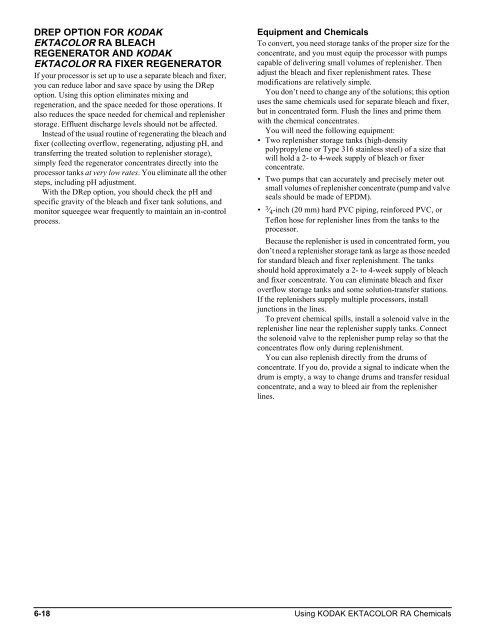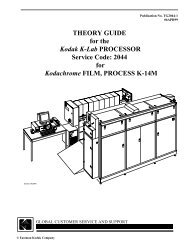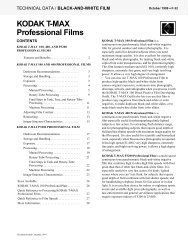6 Processing Options with KODAK EKTACOLOR Chemicals - 125px
6 Processing Options with KODAK EKTACOLOR Chemicals - 125px
6 Processing Options with KODAK EKTACOLOR Chemicals - 125px
You also want an ePaper? Increase the reach of your titles
YUMPU automatically turns print PDFs into web optimized ePapers that Google loves.
DREP OPTION FOR <strong>KODAK</strong><br />
<strong>EKTACOLOR</strong> RA BLEACH<br />
REGENERATOR AND <strong>KODAK</strong><br />
<strong>EKTACOLOR</strong> RA FIXER REGENERATOR<br />
If your processor is set up to use a separate bleach and fixer,<br />
you can reduce labor and save space by using the DRep<br />
option. Using this option eliminates mixing and<br />
regeneration, and the space needed for those operations. It<br />
also reduces the space needed for chemical and replenisher<br />
storage. Effluent discharge levels should not be affected.<br />
Instead of the usual routine of regenerating the bleach and<br />
fixer (collecting overflow, regenerating, adjusting pH, and<br />
transferring the treated solution to replenisher storage),<br />
simply feed the regenerator concentrates directly into the<br />
processor tanks at very low rates. You eliminate all the other<br />
steps, including pH adjustment.<br />
With the DRep option, you should check the pH and<br />
specific gravity of the bleach and fixer tank solutions, and<br />
monitor squeegee wear frequently to maintain an in-control<br />
process.<br />
Equipment and <strong>Chemicals</strong><br />
To convert, you need storage tanks of the proper size for the<br />
concentrate, and you must equip the processor <strong>with</strong> pumps<br />
capable of delivering small volumes of replenisher. Then<br />
adjust the bleach and fixer replenishment rates. These<br />
modifications are relatively simple.<br />
You don’t need to change any of the solutions; this option<br />
uses the same chemicals used for separate bleach and fixer,<br />
but in concentrated form. Flush the lines and prime them<br />
<strong>with</strong> the chemical concentrates.<br />
You will need the following equipment:<br />
• Two replenisher storage tanks (high-density<br />
polypropylene or Type 316 stainless steel) of a size that<br />
will hold a 2- to 4-week supply of bleach or fixer<br />
concentrate.<br />
• Two pumps that can accurately and precisely meter out<br />
small volumes of replenisher concentrate (pump and valve<br />
seals should be made of EPDM).<br />
• 3 ⁄ 4-inch (20 mm) hard PVC piping, reinforced PVC, or<br />
Teflon hose for replenisher lines from the tanks to the<br />
processor.<br />
Because the replenisher is used in concentrated form, you<br />
don’t need a replenisher storage tank as large as those needed<br />
for standard bleach and fixer replenishment. The tanks<br />
should hold approximately a 2- to 4-week supply of bleach<br />
and fixer concentrate. You can eliminate bleach and fixer<br />
overflow storage tanks and some solution-transfer stations.<br />
If the replenishers supply multiple processors, install<br />
junctions in the lines.<br />
To prevent chemical spills, install a solenoid valve in the<br />
replenisher line near the replenisher supply tanks. Connect<br />
the solenoid valve to the replenisher pump relay so that the<br />
concentrates flow only during replenishment.<br />
You can also replenish directly from the drums of<br />
concentrate. If you do, provide a signal to indicate when the<br />
drum is empty, a way to change drums and transfer residual<br />
concentrate, and a way to bleed air from the replenisher<br />
lines.<br />
6-18 Using <strong>KODAK</strong> <strong>EKTACOLOR</strong> RA <strong>Chemicals</strong>

















